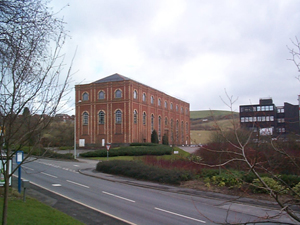Historic Landscape
Characterisation
Merthyr Tydfil
008 Dowlais Iron Works Area
HLCA 008 Dowlais Iron Works Area Industrial Area: former
ironworks site; nationally and internationally important historic, technological,
and artistic associations; site of ironmaster's residence; water management
and power generation.
Summary
Dowlais Ironworks was founded in 1759, and went on in the 19th century to become the largest ironworks in the world. The area now forms an industrial park with significant standing remains, such as the Blast Engine House, toether with buried remains including the base of the Blast Furnaces.
Historical background
The historic landscape area of Dowlais Iron Works Area encompasses site of the ironworks founded in 1759 by a partnership headed by Isaac Wilkinson, an ironmaster from Bersham, Clwyd. The change over to the production of bar as opposed to pig iron was comparatively late at Dowlais. The lack of success in applying Peter Onions' puddling process dissuaded all but John Guest from investing in the technology during the 1780s and Dowlais continued to supply pig iron to Penydarren and Cyfarthfa. The Dowlais works was the first in Merthyr Tydfil to install Steam blowing engines, replacing waterwheel-powered bellows in 1798.
The Works at Dowlais was to become strongly associated with the Guest family; first John Guest, then his son, Thomas Guest (1787) and in turn by his son Josiah John Guest (1807), a liberal who advocated free trade and Merthyr's first MP, following the 1832 Reform Act. It was a result of the latter's vision and business acumen that Dowlais became the largest ironworks in the world. The rails for the Stockton and Darlington Railway were produced at the Dowlais works in 1821 heralding the rewards to come of the railway boom years of the 1830s and 1840s. Technological advances such as the adoption of the 'hot blast technique', patented in 1828, which substantially reduced the amount of coke required for smelting, enabled Dowlais to maintain its competitive edge. Further mills were constructed to produce rails: the Big Mill in 1830, supplemented by the Little Mill in 1840.
William Menelaus was appointed general manager in 1856 and soon after the Dowlais works began experimenting with a new process developed by Henry Bessemer. Menelaus was to oversee the conversion to steel production, which began in a limited fashion in 1865. The local ironstone was unsuitable for the production of steel, due to its high phosphorous content and by the 1870s ironstone mining had ceased altogether in the Merthyr area. Based on imports, chiefly from Spain, steel production would ultimately transfer to coastal sites, such as the new steelworks built by the Dowlais Company at East Moors in Cardiff in 1891. In 1905, under GKN a new blast Furnace complex, which included two American designed 'Yankee' furnaces and a new mill was added. However, after a period of prolonged decline, in 1930 the production of steel at Dowlais finally came to an end.
The early development of the works can be charted from cartographic sources, including estate maps and early OS maps and surveyor's drawings, the Tithe map of 1850 and unpublished map of 1851, among others. The extent of the ironworks development is well demonstrated by the 1878 6-inch OS map, which in part reflects the conversion of the works to steel production in the years after 1865. Numerous features were recorded within the area including charging bank, furnaces and brick kilns among other industrial features southeast of Dowlais House. Other features shown are engine houses, levels, a brickworks, the reservoir to the south of Dowlais House, Cae-Harris Pond, adjacent cottages on Pond Street (now demolished), the Dowlais Railway and numerous railway sidings and tramroads. GGAT Mill, Coed Cae pond, and an adjacent row of cottages (demolished by 1905) were located to the south the area.
Significant changes occurred in 1905 when the plant was remodelled under GKN: additional reservoirs and extensive coke ovens were built in the area to the north of the brickworks, which itself had been extended. The Goat Mill was enlarged and Cae-Harris station had been constructed; this included a goods shed, an engine shed and cattle pens. Further alterations indicated by 1919 were primarily in the area to the southeast of Dowlais House and the blast engine house (now listed grade II), and included additions to the furnaces.
